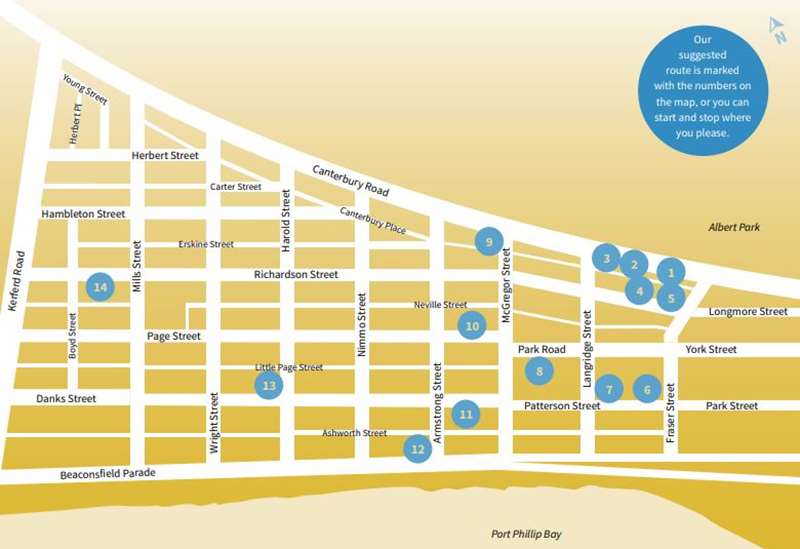Middle Park Walk (Woodcraft in Middle Park Architecture)

While some parts of inner Melbourne are recognised for their cast iron decoration, Middle Park is equally notable in having timber-based decoration on its houses. Timber commonly replaced cast iron after about 1895, up to about 1925, the period during which most Middle Park houses were built. This brochures identifies a range of timber decorations around the area, and will help you identify many other good examples
Map of Self-Guided Walk Route

1 169-172 Canterbury Road
This double pair of houses has some of the best examples of timber fretwork decoration in Middle Park. With their sinuous curves and delicate lacework, they reflect the Art Nouveau style of the turn of the 20th century, especially prevalent in France. Some of the entrances to the Paris underground epitomise this style. Note that each of the pair of verandahs is different, although sadly numbers 169 and 171 have a section missing. It is likely these timber bracket decorations were stock items from a supplier's catalogue, so there may be others in Melbourne. Numbers 171 and 172 repeat the design, but are less visible due to garden growth and being red-brown, rather than white in colour.
2 147 and 148 Canterbury Road
This pair of houses demonstrates how gables could be used to embellish and distinguish what is essentially a simple pair of cottages. In this case the gable is not only projected out over the elaborate bay window, supported by two large brackets, but in turn supports a second projection supported by a row of smaller, solid wood brackets. The fascia on the gables is also broken and shared by the two projections.
3 144 Canterbury Road
This house, while still using wood decoration in the Arts and Crafts style with its elongated cut-out motif, has the more geometric form of modernist architecture, as well as a hint of the premodernist decorative style of Rennie Mackintosh.
4 333 Richardson Street
This house demonstrates a form of the integration of cast iron and wood decoration. The capitals on the wooden posts are made-up of cast iron sections to form a whole. The verandah frieze is otherwise simple, made up of small turned balusters. The arched, tripartite window has heavy turned pilasters adding to the window's prominence.
5 353 and 335 Richardson Street
Number 353 is a good example of the transition from cast iron to wood. Cast iron panels act as infill for a wooden frieze frame and wooden pillars which support a fairly conventional wood and stucco central gable on the verandah, as well as a decorated barge board on the main roof, similar to 335 Richardson Street, but here without the double gable.
6 67-71 Patterson Street
These three houses all have the same decoration. The gable uses a wood-stucco combination of inverted curves in the shape of a cross above the bay window. While number 71 has some features removed, number 69 retains these features and shows the fan-like brackets which reflect a Japanese theme also fashionable at the turn of the 19-20th centuries.
7 45 Patterson Street (a.k.a. 47 Langridge Street)
This corner site house has an elaborate wooden verandah which wraps around the facades. While generally conventional, the posts are heavier than usual, and square. The bay window with its angled (rather than square) sides is completely of wood (rather than brick) and has panelled doors enabling outside access, as do other wood French doors.
8 10-18 Park Road (and 170-174 Page Street)
This terrace of five houses is linked not only by a continuous roofline, punctuated by three wood and stucco gables (surmounted by a terracotta mythical beast), but by the continuity of the simple, vertical square balusters above a gently curved bottom rail. A terrace of three houses at number 170-174 Page Street has similar decoration suggesting the same architect or builder.
9 118 Canterbury Road
The entrance porch and large bay window utilise wood decoration on a grand scale. The bay window has heavy brackets supporting the gable, and a smaller adjacent window also has a canopy supported by smaller brackets. The entrance gable with its square spandrels, leads to a particularly elaborate panelled door section enclosing leadlight windows. While the overall theme is Arts and Crafts, the two round porthole windows suggest an Art Nouveau style.
10 229 and 231 Page Street
This pair of identical houses uses wood decoration reduced to a simple geometric pattern instead of curves and scrolls. Notice that, despite being otherwise identical, each house has subtle differences. They hint at a simpler emerging modern architecture.
11 370 Danks Street
This house makes use of heavily accented gables and leadlight. The elaborate porch gable is supported by heavy brackets, while the many leadlight windows accentuate the porch and dominant bay window.
12 255 Beaconsfield Parade
While this large, multi-roofed corner house does not make widespread use of wood, it does have large areas of painted wooden shingles enclosing oversized attic dormers.
13 72-78 Harold Street (and 36-42 McGregor Street)
These four terraces all have a simple shallow arch supporting square spandrels. In contrast to the simple wood decoration, the use of strong plaster decoration on the front window gives character to the houses. Like many speculative built houses in Middle Park, the same style is repeated, for example, at 36-42 McGregor Street.
14 178 Richardson Street
This house makes a particularly bold statement in wood with large sinuous curves sprung off heavy brick pillars. It strongly reflects the Art Nouveau style.
Note: This publication was produced by the Middle Park History Group which is dedicated to helping residents and others appreciate the history of Middle Park. Free walk brochures are available from the four City of Port Phillip Libraries, the Emerald Hill Heritage Centre and various community centres throughout the City. Download this walk brochure.
Location
169-172 Canterbury Road, Middle Park 3206 Map
Web Links
→ Woodcraft in Middle Park Architecture Brochure (PDF)
→ middleparkhistoryg.wixsite.com/mphg











